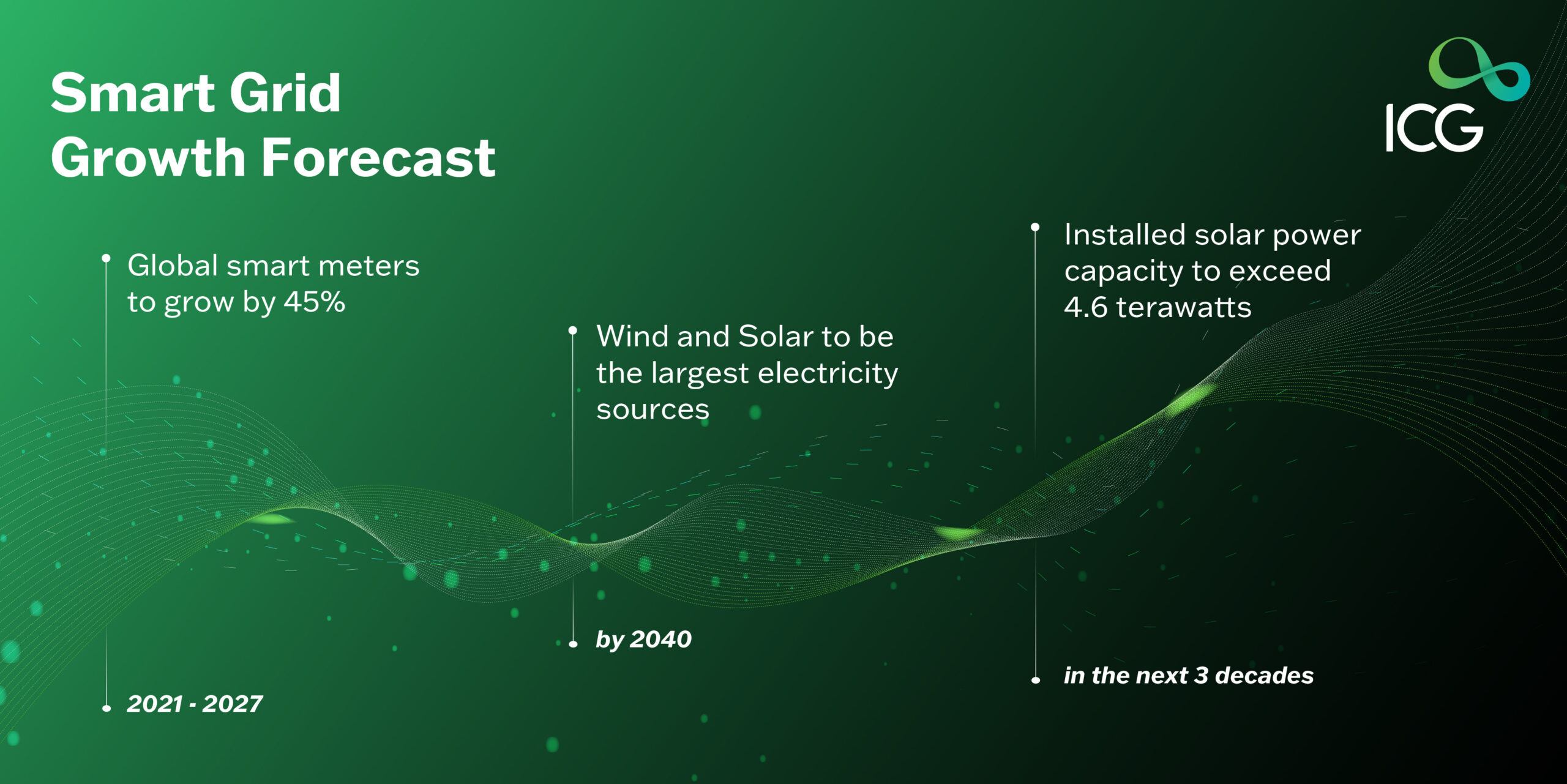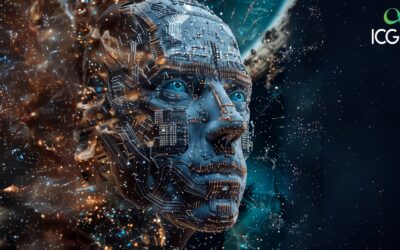Electricity was a considerable innovation a long time ago. However, some areas still don’t get enough electricity. The reason? Imbalanced demand and supply. Enter digital technology called Smart Grids to form electricity networks to manage demand and supply in real-time. This dramatic transformation is a result of an elevated need for resilience, efficiency, and sustainability. Smart Grid makes it possible with a sophisticated and flexible energy infrastructure evolved with intelligent and cutting-edge technologies like AI, blockchain, and IoT. With a promise to evolve continuously, smart grids use a modernized electricity production and consumption technique to reduce costs for better energy management.
What is a Smart Grid?
Think of a Smart Grid as a CRM (Customer Relationship Management) system. Before the internet took over, businesses used to keep static customer records. There was very little to no scope for interaction and engagement. Today, with social media being a pocket-necessity, enterprises opt for continuous two-way communication with customers. Data analytics has made it easy to predict customer needs and improve their experience with customization. Likewise, smart grids use real-time analytics to monitor energy usage and predict future demand by using two-way communication to become more responsive.
Likewise, smart grids use two-way communication to monitor energy usage in real-time, predict future demands, and optimize energy distribution, offering a more responsive and efficient energy service. The attached smart meters in the smart grids monitor the energy usage of your home, office, or anywhere it is installed and communicate the same with the power company in real-time to adjust the energy flow according to your requirements. Unlike traditional systems, smart grids are designed to allow two-way communication between utilities and consumers regarding energy requirements.
Key Technologies Behind Smart Grids:
- AI and Machine Learning: Use real-time data to predict demand patterns and optimize energy distribution.
- Smart Meters: Monitor real-time energy usage and share the data with consumers and utilities.
- Sensors and IoT Devices: Continuously monitor the grid conditions to share real-time data and requirements.
- Blockchain: The digital chain ensures a secure and transparent connection of energy transactions.
- Energy Storage: Store and manage all the excess renewable energy for later use.
The Urgency for Smart Grids
Global acknowledgment of technologies like AI and ML intensifies the worldwide need for smart grid applications.
- Rising Global Energy Demand: The U.S. Energy Information Administration (EIA) released its International Energy Outlook 2016 and projected a growth of 48% in the world’s energy demand between 2012 to 2040. Additionally, the countries with solid demand for economic growth are projected to have more energy demands. Traditional grids cannot be sufficient to handle this surge.
- Renewable Energy Adoption: The World Economic Forum explained in their 2023 Agenda that more than 1 third of the energy worldwide will be generated by renewables in 2025. Solar PV and Wind, with 95% expansion, overtake Coal to become the most significant energy source by early 2025, explained the International Energy Agency (IEA) in their news.
- Climate Change: As global warming is on the rise and weather events are extreme, traditional grids are prone to outages. The World Economic Forum (WEF) reported that we need to increase clean power generation by 3X by 2030 and 9X by 2050 if we want to cope with this extreme global warming.
- Decentralization of Energy: Solar Panels have been in the market for over a decade. Millions of consumers have started installing that and other decentralized energy systems to eliminate traditional grid management.
Key Technologies Powering Smart Grids
- AI and Machine Learning
Topping the list, AI and ML are the most revolutionary technologies to date. From analyzing the vast amount of data collected from sensors and smart meters to optimizing the energy flow, AI and ML make it easy to detect anomalies in the grid and predict demand surges.
- California’s Pacific Gas & Electric (PG&E) integrated AI in their systems to detect real-time errors and faults in the systems, ultimately reducing wildfire risks by 20%.
- The UK National Grid used AI systems to forecast energy demands, and it helped them improve 15% accuracy in load management and reduced annual energy costs by $300 million.
- Blockchain for Decentralized Energy
Blockchain, a highly transparent decentralized energy trading system, improves data integrity for millions of prosumers.
- As a part of Vision 2030, Saudi Arabia has also explored blockchain technology to support renewable energy goals. Saudi Aramco, one of the largest energy producers in the world, has incorporated blockchain-based solutions to transparent trading. The King Abdullah City for Atomic and Renewable Energy (K.A.CARE) is integrating solar power and other energy sources into the national grid as a part of blockchain investment.
- Energy Storage Solutions
Technologies, like pumped hydro storage and lithium-ion batteries, make storage solutions easy to balance the variable energy of renewable sources. These storage solutions store the excess power generated during low-demand seasons and release it during high-demand seasons.
- A worldwide known name, Tesla, has its own battery storage solution, Tesla Megapack. South Australia’s Hornsdale Power Reserve uses this storage solution and is believed to reduce energy costs by $40 million within the first two years of its application.
- Internet of Things (IoT)
Devices like smart meters and sensors communicate over a network to provide real-time data to monitor and manage the grid with IoT.
- In the US, over 75% of households are equipped with a smart meter and have been working for a while now to reach 100% smart meter penetration.

Real-World Applications of Smart Grids
- Middle East: Saudi Arabia’s NEOM
Saudi Arabia, being at the forefront of the Smart Grid Market in the MENA region, is building the largest smart city in the world – NEOM. This area will rely entirely on renewable energy integrated with advanced smart systems to power grid technology. NEOM is expected to generate 30 gigawatts of clean energy while reducing around 50% of the country’s carbon footprint by 2030.
- UAE: DEWA’s Initiatives
Dubai being at the top of adopting new technologies every now and then has the Dubai Electricity and Water Authority (DEWA) for its smart grid development. With its Smart Grid Strategy 2021-2035, DEWA is investing in AI, IoT, and blockchain in various areas. Blockchain interaction allows users to charge their EVs and the digital DEWA division allows prosumers to trade excess energy.
- Oman: Smart Metering
Nama Group from Oman has recently launched their smart metering project to automate meter reading. With IoT, real-time data will help reduce energy waste. With AI algorithms, consumption prediction will be easy to save millions of dollars in operational costs.
- Qatar: Smart Development beyond 2022 FIFA World Cup
Qatar extended its 2022 FIFA World Cup sustainability concept to energy management with smart-grid technology integration in infrastructure development. The Kahramaa Smart Grid National Program integrated smart meters and energy storage systems to distribute efficient energy across and beyond World Cup venues and help Qatar transition to being more sustainable.
- Europe: Initiative for Smart Grid Investment
The European Commission made waves with its bold commitment to invest 20 billion euros into clean energy, backing smart grid initiatives across the continent. With this massive push, Europe is not only setting the stage for reduced emissions but is also aiming to achieve 100% smart meter adoption by the end of this year—a significant leap toward a more sustainable future.
- The United States: Texas Power Crisis and Grid Modernization
The United States and its winter storms are famous worldwide. During the 2021 Texas winter storms, the traditional power grid was exhausted and couldn’t meet the sky-high energy demands. Millions of people were living without electricity. The Electric Reliability Council of Texas (ERCOT) then concluded in research that smart grid technologies could have saved the city from this disaster. It would have reduced blackouts by managing the electricity demand dynamically and routing the power from unaffected areas. Texas now invests in smart grid technologies like data sensors and automated load management systems to support its people and prevent life from future crises.
The U.S. government, in 2022, funded the nation’s power grid with over $13 billion to modernize it with more resources and better infrastructure that includes renewable integration with AI and IoT technologies to the energy market.
- China: Smart Grid Leadership
China being a rabbit in the global race, leads it as State Grid Corporation of China (SGCC) plans to invest $350 billion by 2030 to develop smart grid infrastructure in the country. For AI, the country is already ahead with integrated systems to manage over 1,000 gigawatts of electricity, leaving behind every other country in the world. Not only this, but the corporation is also using blockchain technology to decentralize the server for secure energy transactions. They believe consumers can help each other and the planet by selling and buying surplus solar power.
- Germany’s Transition to Renewable Energy
Germany is still catching up in the race. Focused on its ambitious Energiewende (energy transition) plan, Germany now has renewables to generate about 50% of its electricity. The country relies heavily on smart grids to manage all its renewable energy generated from solar and wind. Germany implemented AI algorithms in its systems in 2023 to predict the energy demand. With an accuracy of 94%, the grid automatically adjusts to the power distribution and waste management.
Blockchain in Germany’s smart grid plot projects like Brooklyn Microgold let the local households transparently trade their energy with high security.
Challenges and the Road Ahead
Smart grids are undeniably impressive in their scope, yet they still combat a few key challenges:
- Cybersecurity Risks: The digital revolution has brought a surge in cyberattacks, making it crucial to invest in cutting-edge security measures and robust cyber defenses.
- High Initial Costs: Revolution and growth starts with high investment. Smart grids require great infrastructure and high upfront costs.
- Regulatory Hurdles: Utilities need to engage with the government to design policy and regulatory frameworks, overcoming outdated rules to make the technology seamless.
The Future is Smart
Being smart doesn’t only mean technological upgrades, but also being able to adopt a better future. Smart grids represent a better future, a promise to offer enhanced efficiency and reliability with a sustainable future.
Ongoing investment in AI and blockchain technology is transforming smart grids, enabling seamless integration with renewable energy to meet rising energy demands without harming the environment. The benefits far outweigh the challenges, which can be minimized when individuals and businesses align their thinking and make informed decisions. Smart grids are the driving force behind the future of energy transformation.
The ICG Approach
At ICG, we offer a customized approach that empowers your teams with the latest insights and technology expertise to navigate the demands of today’s digital age. As Saudi Arabia embarks on its digital transformation journey, ICG plays a pivotal role in shaping the Kingdom’s tech landscape by providing cutting-edge solutions, strategic consultancy, and fostering innovation. Our comprehensive guidance, from fundamental concepts to practical implementation, helps organizations mitigate risks, stay ahead of the competition, and unlock their full potential in the accelerating digital environment.
Ready to talk?
Request your free Consultation to learn more about ICG’s capabilities and enablement to embark on a transformative expedition toward the summit of success.








